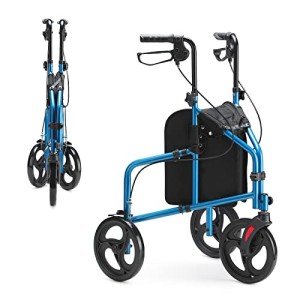
Medical Walker
Add a review FollowOverview
-
Founded Date December 16, 1956
-
Sectors Telecommunications
-
Posted Jobs 0
-
Viewed 41
Company Description
5 Killer Quora Answers On Adjustable Walker
Understanding Adjustable Walkers: A Comprehensive Guide
Adjustable walkers are essential mobility aids designed to provide stability and support to people with mobility obstacles. They boost independence, safety, and self-confidence for people recovering from surgery, handling persistent conditions, or dealing with age-related mobility concerns. This post dives into the features, types, benefits, and typical FAQs related to adjustable walkers, providing insights for potential users and caregivers.
What is an Adjustable Walker?
An adjustable walker is a mobility aid that normally includes a lightweight frame with 4 legs, geared up with handgrips for support. It can be adjusted to accommodate different heights, guaranteeing users achieve a comfy wrist position while supporting their weight. Adjustable walkers been available in different styles, each tailored to particular needs.

Key Features of Adjustable Walkers
- Height Adjustment: Most adjustable walkers have telescoping legs, allowing users to quickly customize the height to suit their stature.
- Weight Capacity: Different models accommodate varying weight limits, catering to a broad demographic.
- Foldability: Many walkers are collapsible, making them easy to store and transportation.
- Wheels vs. No Wheels: Some walkers feature wheels on the front legs, while others have a basic style without wheels, promoting stability.
- Additional Accessories: Walkers can frequently be equipped with trays, baskets, or cup holders for included benefit.
| Function | Description |
|---|---|
| Height Adjustment | Telescoping legs for customized height settings |
| Weight Capacity | Varies by design, supporting various body weights |
| Foldability | Collapsible style for simple transport and storage |
| Wheels | Offered in both wheeled and non-wheeled alternatives |
| Additional Accessories | Trays, baskets, and cup holders for user convenience |
Types of Adjustable Walkers
- Standard Walkers: Traditional designs with 4 legs. Best for those looking for optimum stability.
- Wheeled Walkers (Rollators): Walkers with two or more wheels, permitting much easier maneuvering.
- Hemi Walkers: Designed for people with making use of one hand, featuring a single arm support for included stability.
- Infant Walkers: Specifically created for babies learning to walk, promoting safety and support throughout early mobility.
Benefits of Using Adjustable Walkers
Boost Independence
- Boosted Mobility: Adjustable walkers allow users to navigate their environments with more ease and self-confidence, promoting a sense of independence.
- Ease of access: With the ideal walker, users can keep their lifestyle and participate in activities they take pleasure in without support.
Injury Prevention
- Stability and Support: Walker users can maintain much better balance and prevent falls, which are particularly important for seniors and people recovering from surgical treatment.
- Decreased Strain: Proper use of a walker can relieve stress on joints and muscles, reducing the danger of injury throughout mobility.
Convenience and Customization
- Adjustable Settings: Walkers can be tailored to each user’s height and comfort, providing a more tailored experience.
- Extra Features: Options for accessories assist in accommodating individual requirements, allowing users to carry products while moving.
Expenses and Considerations
The price of adjustable walkers varies depending on features, products, and brand name. Here’s an introduction of the average expenses associated with various types:
| Walker Type | Average Cost |
|---|---|
| Requirement Walkers | ₤ 50 – ₤ 100 |
| Wheeled Walkers | ₤ 75 – ₤ 200 |
| Hemi Walkers | ₤ 60 – ₤ 150 |
| Baby Walkers | ₤ 30 – ₤ 70 |
Regularly Asked Questions (FAQs)
1. How do I understand which adjustable walker is right for me?
The best adjustable walker depends on your particular requirements, physical condition, and environment. It’s vital to seek advice from a healthcare professional to figure out the most suitable type.
2. Can I change the height of any walker?
The majority of adjustable walkers feature a height-adjustment mechanism. Nevertheless, not all walkers are adjustable. It’s vital to examine product specs before buying.
3. Are wheeled walkers safe to use?
Yes, wheeled walkers (or rollators) are safe for users who can navigate them properly. They frequently consist of brakes for included safety when fixed.
4. How do I care for my adjustable walker?
Routine care involves cleaning up the walker with mild soap and water, looking for wear on grips and wheels, and guaranteeing mechanisms run efficiently.
5. Can I take my adjustable walker on public transport?
Yes, numerous adjustable walkers are foldable and designed for simple transportation. Nevertheless, it’s suggested to inspect the specific guidelines of the transportation service.

6. Do I need help to use an adjustable walker?
Many users can operate adjustable walkers independently, particularly when effectively fitted to their height. However, those with serious mobility problems may benefit from assistance.
Adjustable walkers are vital tools for boosting mobility, independence, and safety. With a variety of design and styles, people can discover a walker tailored to their needs. Caregivers and users alike should appreciate the significance of seeking advice from healthcare experts to make informed choices concerning mobility aids. Understanding the functions, benefits, and considerations of adjustable walkers empowers people to keep an active lifestyle, enhancing their quality of life in spite of mobility obstacles.


